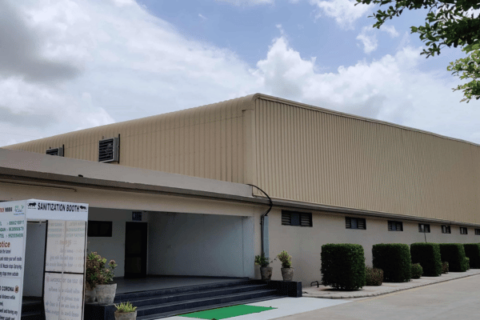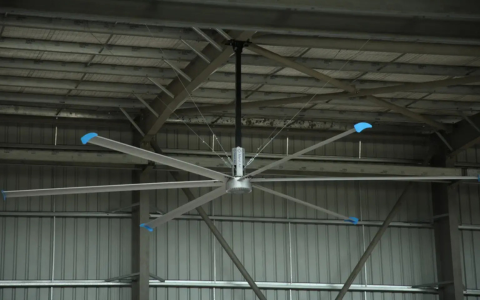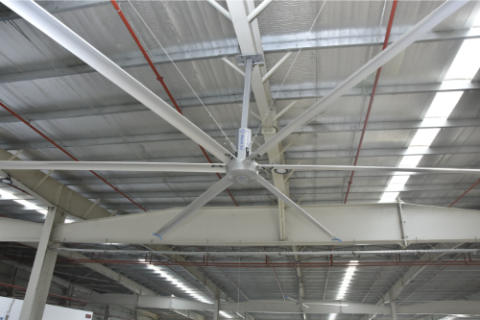In large industrial spaces, maintaining a comfortable working environment is not just about employee comfort—it’s also about productivity, safety, and energy efficiency. Two of the most common climate control options are HVLS Fans and traditional air conditioning systems. But which is the better fit for industrial settings? Let’s break down the comparison and find out why HVLS fans, like those offered by Marut Air, are gaining popularity across industries.
What Are HVLS Fans?
HVLS (High Volume, Low Speed) fans are large-diameter ceiling fans designed to move a massive amount of air at a low speed. Unlike small, high-speed fans, HVLS fans gently circulate air across wide areas, creating a consistent and comfortable breeze throughout the space.
Air Conditioning in Industrial Spaces: The Limitations
While air conditioning is a common choice for temperature control in homes and offices, it may not always be ideal for industrial environments due to several reasons:
- High Energy Consumption: AC units consume a large amount of electricity, especially when trying to cool vast, open industrial areas.
- Costly Installation & Maintenance: Installing an industrial-scale HVAC system involves a significant upfront cost, along with ongoing maintenance expenses.
- Poor Air Circulation: Even when cooling the air, AC systems can fail to evenly distribute temperature in high-ceiling or open-layout environments.
Why HVLS Fans Are the Better Choice for Industrial Use
Here’s why HVLS Fans from Marut Air are proving to be a smarter investment for warehouses, manufacturing plants, and other industrial settings:
1. Energy Efficiency
HVLS fans consume a fraction of the electricity compared to traditional AC systems. A single HVLS fan can cover up to 20,000 square feet, reducing the need for multiple cooling units.
2. Cost-Effective
With lower operating costs and minimal maintenance needs, HVLS fans offer long-term savings. They also reduce the load on existing HVAC systems when used together.
3. Improved Air Circulation
HVLS fans create a uniform airflow, eliminating hot and cold spots and improving overall air quality. This helps in keeping both people and equipment cool.
4. Year-Round Comfort
These fans aren’t just for summer. In winter, they can be run in reverse to circulate warm air that rises to the ceiling, improving heating efficiency.
5. Environmentally Friendly
With reduced energy use, HVLS fans contribute to lower carbon emissions—making them an eco-friendly choice for responsible businesses.
What are the Major Differences Between HVLS Fans & Air Conditioning?
Here are some key differences between HVLS fans and air conditioning:
| Aspect | HVLS Fans | Air Conditioning (AC) |
| How They Work | Move large air volumes & create breeze for comfort | Remove heat & humidity and lower air temperature |
| Cooling Effect | Perceived cooling (feels 5°F to 8°F cooler) | Actual cooling with controlled temperature |
| Energy Use | Low power consumption | High electricity use |
| Cost | Lower install & running cost | Expensive install & maintenance |
| Airflow | Improves circulation, reduces condensation, balances heat in winter | Limited coverage, uneven cooling |
| Extra Benefits | Year-round use (cooling and heating support) | Dehumidifies air |
| Best For | Large open spaces (warehouses, factories) | Spaces needing strict temperature & humidity control |
| Limitations | Doesn’t lower actual temperature | High costs, uneven distribution |
When Air Conditioning May Still Be Necessary
During extreme heat and heatwaves, air conditioning is critical for human health, both directly from heat and also by curtailing humidity-related health issues such as mold and pest contamination. Air conditioning is also critical for many industries that rely on air conditioning to limit the temperature of mechanically active items (computers, electronics, medications, equipment, etc.) limit worker exposure to temperature-affecting decision-making and to a certain extent, assist in preserving agricultural products in general and fermented foods in particular. Acquiring air-conditioning and using it wisely is becoming a more prevalent demand across various parts of the planet as global temperatures increase across the globe.
The Marut Air Advantage
At Marut Air, we specialize in innovative and reliable HVLS Fans that are engineered for performance and durability. Whether you operate a factory, warehouse, or distribution center, our solutions are tailored to enhance comfort while optimizing operational costs.
Final Thoughts
While air conditioning may still be necessary in certain controlled environments, for most industrial settings, HVLS Fans offer a more sustainable, economical, and efficient solution. If you’re looking to improve airflow and reduce energy bills without compromising comfort, Marut Air’s HVLS Fans are the smart way forward.
Ready to make the switch to HVLS technology? Contact Marut Air today and discover how our fans can revolutionize your industrial space.
Frequently Asked Questions About HVLS Fans vs. Air Conditioning
Question 1. How much electricity do HVLS fans save compared to traditional AC systems?
Answer. HVLS fans significantly reduce the electricity consumption compared to traditional AC systems by improving air circulation and can save up to 30% or more on cooling costs.
Question 2. Do HVLS fans improve worker comfort and productivity in factories?
Answer. Yes, HVLS fans improve worker comfort and productivity in factories by circulating air, reducing heat stress, decreasing humidity and improving air quality.
Question 3. Which is better for open spaces, HVLS fans or air conditioning?
Answer. HVLS fans are generally better than air conditioning for large open spaces because of their significantly lower operating cost, energy efficiency and ability to effectively circulate air.
Question 4. Do HVLS fans require a lot of maintenance to keep working effectively?
Answer. No, HVLS fans are generally considered low maintenance as compared to air conditioning systems.





